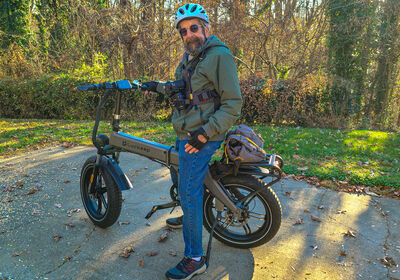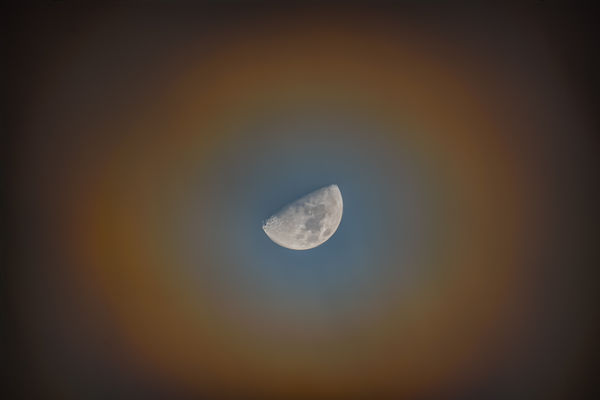Human eye vs the camera
Jan 9, 2020 08:44:20 #
Jan 9, 2020 08:50:12 #
Jan 9, 2020 09:09:28 #
grahamfourth wrote:
Last night the moon was behind some clouds creatin... (show quote)
The human mind also comes into play. The mind, through practice, develops ways of interpreting and adjusting the perception of what is seen in the moment. The mind mentally adjusts the perception of relative brightness of different items in the field of vision based on memory, experience and repetition. Sometimes these remembered adjustments are referred to as "engrams". Engrams relate to a whole range of memory issues but have a particular application to vision. A camera has no equivalent to the engrams of the human mind. As a result a single shot is unlikely to ever capture what the photographer perceives with the human eye. This is where post processing, as practiced by most photographers since photography began, comes in. This is also why the photographer's vision before setting up, composing and pressing the shutter is so important. It is this vision that guides post processing.
Jan 9, 2020 09:17:44 #
grahamfourth wrote:
Last night the moon was behind some clouds creatin... (show quote)
Your question is one that I've wrestled with in my own shots of the moon, and I have succeeded in my own way to create satisfyingly well detailed images with excellent contrasts and gradations. Your particular question related to the capture of the finely colored filminess of the cloud/mist in front of the moon could be attacked in a similar way.
Just as I used to take test strips with my enlarger in "the old days," I took series of shots of the moon at faster and faster shutter speeds. I wanted to ensure I didn't blow out any areas due to excessive brightness). I used my Tamron 150-600mm on my D500 at f/8, max telephoto. Combining the final intentionally underexposed images (shot at 1/2000th of a second), with the various contrasts and darkness controls of Photoshop, I found that as I moved the brightness, contrast, shadows and black sliders, the moon's rough terrain showed up in dramatic fashion. I further enlarged the final image and isolated it with the rectangular marquis tool to fill the screen.
Others UHH members have used different optics and very different exposures to achieve amazing results. Perhaps they'll share their final images and strategies, too.

Jan 9, 2020 09:20:02 #
I have read with interest, every message posted. You all put a smile on my face. Why? In my fall physics class, we spend weeks studying light. I begin it be sharing with my students that our vision (all parts as a team) can process an "intensity range" of approximately a trillion-to-one. A camera can process far less, as described in the above posts. The point I'm wanting to make is that all dedicated photographers should consider learning HDR, for it can greatly expand the dynamic range of any camera.
Jan 9, 2020 09:46:21 #
gvarner
Loc: Central Oregon Coast
Your eyes don’t really see all that detail between light and dark. Your brain fills in the blanks on the things that you’re not looking directly at and focusing your attention on. A camera can’t do that. That’s why techniques like HDR are so popular. The technology fills in the blanks.
Jan 9, 2020 10:02:06 #
Jan 9, 2020 12:08:57 #
nadelewitz
Loc: Ithaca NY
grahamfourth wrote:
Last night the moon was behind some clouds creatin... (show quote)
If you think the wonder of the human vision and all of its intricacies can be explained, guess again.
You photograph brighter and dimmer together by averaging the exposure for the individual elements, compromising, or decide which has priority. This is what modern camera brains do. Of course, you can use your own brain and do it manually.
Jan 9, 2020 12:15:21 #
CHG_CANON wrote:
For the second question, about exposure, use the Spot metering option with the moon centered in the frame. The camera will ignore the darkness of the sky and just consider the bright moon for an exposure setting. Use your editing tools, especially if captured in RAW, to adjust the relative brightness of the moon to the other details in the image to arrive at an image that is your desired representation of what you experienced.
Without adjustment that would give you a grey moon. Use the spot meter AND add 1-2 stops additional exposure - this will make the moon brighter without blowing it out. Of course a few test shots are always a good idea when shooting the moon.
Jan 9, 2020 12:27:28 #
billnikon
Loc: Pennsylvania/Ohio/Florida/Maui/Oregon/Vermont
grahamfourth wrote:
Last night the moon was behind some clouds creatin... (show quote)
The human eye has a exposure latitude approaching 30 stops. A camera has not been invented yet (may be coming soon) that can match the human eye.
Jan 9, 2020 13:49:39 #
In the past I have marveled at how the moon behind thin clouds, all behind naked tree branches can present such a challenge to photograph. The range of brightness is so great. Today I would say the answer is HDR, High Dynamic Range photography, patching together several shots with different exposures.
Jan 9, 2020 14:38:37 #
grahamfourth wrote:
Last night the moon was behind some clouds creatin... (show quote)
The dynamic range of the eye is considerably greater than a camera (at least any camera I've ever owned); thus, being able to see both the Moon's surface features and the surrounding Moon Dog.
As for photographing a Moon / Moon Dog combo, 1) set focus and exposure on the Moon, be sure to shoot in RAW and attempt to bring out the Moon Dog in postprocessing, 2)alternately, shoot subs for the Moon and the Moon Dog separately and postprocess as high dynamic range (HDR).
The attached image was shot using 1) above.
bwa
Jan 9, 2020 15:34:49 #
The simple answer to question one. You eyes have a computer attached that adjusts for lighting automatically. This is why white appears white no matter what the actual color cast the light might have.
Jan 9, 2020 17:11:21 #
grahamfourth wrote:
Last night the moon was behind some clouds creatin... (show quote)
The human eye is really bad at estimating either relative or absolute brightnesses, although training can help. The reason has to do with how the eye forms an image. We only see sharply in the very center of our vision. Everything else is blurry. We seem to see the world sharply because our eye is in constant motion and our brain takes all the sharp bits and builds a composite image. This process takes a while. Consider: a video at 24 fps does not look jerky. This means that we don't have a fully defined image in much less than 40 milliseconds or we would perceive the transition from one frame to the next.
The other part of this equation is the iris. The iris constantly adjusts to the amount of light coming in. It does so on a shorter time scale than is required to build an image. In the bad old days when fluorescent lights cycled with the line current, people would get headaches because their iris was constantly trying to adapt to the on/off cycles. The lights were literally turning on and off 60 times per second, too fast for us to perceive it, but slow enough for the iris to react. This means the iris' reaction time is on the order of 10 to 15 milliseconds.
So while your eye is building that composite image, the iris is adjusting the 'exposure' of each of the constituent bits which tends to even out brightness differences.
Of course, you can still get dazzled moving from indoors to out and vice versa, but your iris is doing its best to keep that to a minimum.
Jan 9, 2020 21:00:45 #
I agree with what is said above. The eye is actually taking a series of shots as the iris adjusts to changing light depending on what you are looking at. You are not actually seeing all the detail at once, the brain is building a composite image more like a video than a still shot. In fact if you use a video camera with an automatic aperture it will capture dark and light areas, but not at the same time. In order to do that in a still pic you need to blend several shots into one. That's what HDR processing does. By blending several versions of a scene at different exposures it brings out the details in the dark areas and the bright areas.
If you want to reply, then register here. Registration is free and your account is created instantly, so you can post right away.








